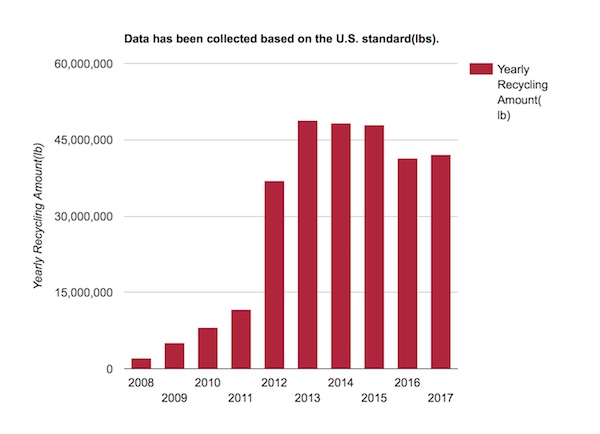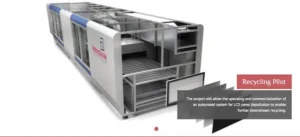Vacation! The time for relaxation and forgetting about the daily news for a while. Nevertheless it is kind of funny how our daily routine still kicks in when we see something unexpected and how unrelated experiences trigger some reflection of our daily thinking. This happened to me when I was spending some time in Greece recently.

This was not the typical beach vacation anyway, but when we had the chance, we took a stroll on a nearby beach and that was when I realized how our daily life was changing the environment at a pretty fast rate.
Let me start with the epiphany we had on our stroll on the beach. While looking for sea glass and shells yielded very little results there was plenty of ‘sea plastics’ around. It not only came in all colors, it was just ground down to small parts, just as sea glass used to be. It seems, sea plastic is the next thing to bring back from your beach vacation. Then I started thinking; if glass is being replaced in our waste stream with plastics, what is with the amount of glass from the good old CRT devices and how does the next generation display technologies compare in the their respective end of life consequences?
A look at our local recycling center shows that by now the disposed TVs aren’t CRT-based anymore, they are the exception of the rule. PDPs and LCDs are making up the bulk of the recycled TVs in our community. I am pretty sure that this is not a local anomaly, but the rule pretty much everywhere in industrial countries. Since most of the CRT TVs and monitors have been disposed of, what is happening to next generation displays technologies? Thinking this maybe an easy thing to research, I found that Google was not returning much in terms of recycling news.
There are of course local laws about the recycling of electronics, which means in most cases that electronic devices of specific types have to be collected and can’t be put in landfills or exported to other countries. As an example, the map of the USA shows which states have such legislation and which states do not. Of course, other countries, like those in the EU, have similar or even stricter laws for example. However, this only dictates that certain types of electronics have to be collected for recycling. They do not spell out what recycling means. In the most crude form this means for example incinerating the whole device. Other forms require an operation of the components to fulfill specific laws about the release of hazardous materials.
 e-waste Recycling Laws in the USA
e-waste Recycling Laws in the USA
This brings up the point of who does the recycling. Today e-waste recyclers are mostly for profit companies that will recycle certain devices to extract certain materials out of the waste that can be recycled into materials used in the display manufacturing process. If they can’t make a profit they will not touch certain devices.
During the recycling of CRT tubes a critical issue was the potential release of lead out of the glass vacuum tube. While recycling of glass is a standard procedure in industrial countries today, adding high lead content glass into the glass recycling stream was not possible. Special recycling was necessary. Most of the LCD devices recycled today have backlight units based on CCFL technology. These backlights were used mainly up to around 2010 before LED backlights became dominant. The backlights contain mercury and need to be separated before the devices can be crushed and further processed. This led to a backlog of LCD screens in the EU waiting for a technology that allows a cost effective processing of these devices.
A group that works in this field is the WEEE Forum, a non-profit organization of global recycling organizations to tackle such issues. The WEEE Forum is mostly driven by EU law but also includes some global organizations. They fulfill a wide range of tasks that are needed to comply with legal requirements. They also were involved in the development of the Revolving, an automatic LCD dismantling machine that separates the various components for further processing. The tools is capable of processing up to 60 LCD screens per hour.
WEEE Forum ReVolv – LCD Screen Separation Machine
They also organized the first International E-Waste Day on October 11, 2018 to increase public awareness of the problems with e-waste. Who knew? According to the WEEE Forum only 20% of the estimated 50 million tons of global e-waste will be recycled on 2018 (35% of e-waste will be recycled in Europe). This amount does include larger appliances and heating / air conditioning equipment. In comparison, in the USA the electronic device manufacturers report their collected device by weight. As shown below, LG, for example, says that they collected about 42 million pounds (19,050 tonnes) of e-waste in 2017. They do not say how many pounds of devices they sell in any given year. Similar data are available form other manufacturers as well.
 USA LG e waste collected totals by weightSo far recycling e-waste is raw material-centric rather than component-centric. In other words, breaking down components to extract specific materials like copper, silver, gold, etc. instead of seeing if components or materials can be reused. For example, it maybe better to use them in other plastic recycling products Instead of incinerating them. The key question is how to do that cost effectively?
USA LG e waste collected totals by weightSo far recycling e-waste is raw material-centric rather than component-centric. In other words, breaking down components to extract specific materials like copper, silver, gold, etc. instead of seeing if components or materials can be reused. For example, it maybe better to use them in other plastic recycling products Instead of incinerating them. The key question is how to do that cost effectively?
From a display standpoint, the LCD panel is typically shredded and the coatings removed and the LCD material extracted after the BLU has been removed. ITRI did show such a process in a YouTube video in 2017 suggesting that they can reuse the extracted LCD material. Considering the different LCD materials in use, this would require operation of the displays before recycling.
Nowhere did I find anything about the recyclability of OLED or QD displays. Considering the different chemistry used in all these new technologies, we can expect some surprises when it comes to recycling these displays. We already know that early quantum dots used selenium, based on the argument of very low concentrations used in the QDs. OLEDs may have similar surprises waiting for us in the coming years. Display technology development is driven by the improvement of key characteristics, but recyclability is just not one of them.
As long as displays stay out of the oceans at least they do not contribute to the sea plastic epidemic. (NH)

